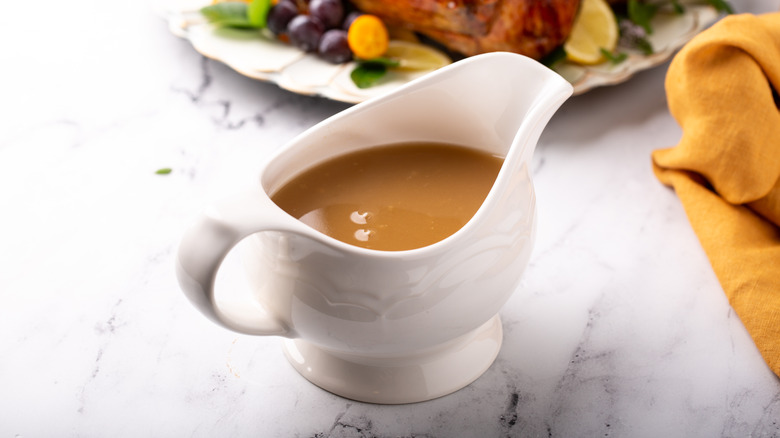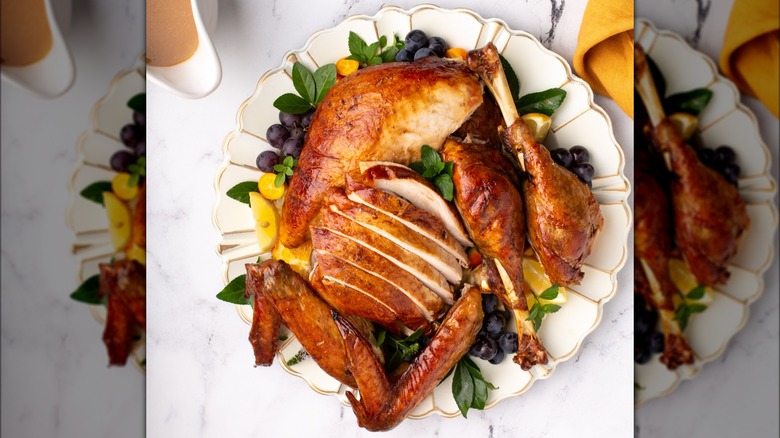Gordon Ramsay's Turkey Is A Lemon Overload
Turkey has a bit of a mediocre reputation, and every chef and home cook has set out to crack the code on a turkey that is both juicy and flavorful. To brine or not to brine? Oil or butter? Simple seasonings or flavor bombs? Spatchcocked or whole bird?
Chef Gordon Ramsay keeps his turkey preparation fairly simple, but the main ingredient he chooses to guide the flavor profile is fresh lemon ... lots of fresh lemon. Now, for those who crave the pucker, this may be the turkey recipe for you. For others in search of a more neutral protein, following Ramsay's recipe may sour Thanksgiving.
Ramsay's recipe includes whole lemons, juice, and zest. The first application is in a compound butter spread both under and on top of the turkey skin — it combines olive oil, fresh parsley, raw garlic, and both the juice and zest of a couple of lemons. The recipe does specify using small lemons but does not give exact measurements to aim for. This is one reason why Ramsay's turkey could skew overly acidic instead of delightfully bright. Ramsay goes on to stuff the cavity of the turkey, with halved onions, a head of garlic, bay leaves, and a whole lemon.
What does all that lemon do to the turkey gravy?
Gordon Ramsay pops the turkey in the oven for a bit at high heat to get the skin to brown, then lays bacon over the breasts to both protect and introduce fat to the leanest part of the bird. Ramsay also said this step is to build flavor into the drippings that will later be used for gravy. It is interesting that Ramsay specifically mentions the gravy, because some consider lemon-infused pan drippings to ruin gravy.
The lemon-laced gravy that Ramsay makes isn't exactly traditional, so perhaps his method pairs more naturally with this turkey recipe than a roux-thickened classic giblet gravy recipe. Ramsay uses the drippings and chops up the crispy bacon from the top of the turkey, the onions from the cavity, and the whole lemon that roasted inside the bird as well — rind and all. He also adds some fresh tomato, the wings of the turkey, and dry apple cider. Chicken stock makes up the rest of the liquid, and once simmered and strained, Ramsay even adds some crushed walnuts.
Finding the right balance
This super citrusy turkey may hit all the right notes for someone who craves an acidic foil to all the rich and creamy dishes that usually make up a Thanksgiving spread. However, for those after more dialed-down, comfy flavors, Gordon Ramsay's take as it is written may not be the bird for you. Try modifying the method to make a bright turkey that doesn't quite cross the line into overly tart.
Consider adding just lemon zest and omitting the juice from the compound butter. Zest packs a big lemon flavor without the overt acidity. If you like the idea of reducing apple cider for the gravy, double down on those autumnal flavors and substitute an apple for the lemon inside the cavity. Apple will provide a more subtle acidity and introduce sweetness to the drippings.
If you like elements of Gordon Ramsay's turkey but want to dial it down, just add less lemon like another celebrity chef. Ina Garten's stress-free Thanksgiving means just serving the classics, and of course that means turkey makes the cut. She likes a simple preparation that uses melted butter infused with the zest and juice from one lemon. She also uses a single lemon in the cavity of the turkey, but Garten famously does a make-ahead gravy to minimize moving parts on the big day. You can save those lemony drippings to make roasted vegetables, start a soup or stew, or amp up the flavor of steamed rice.



